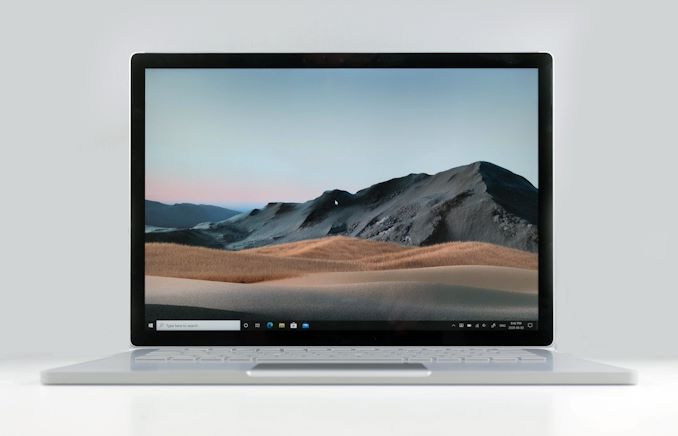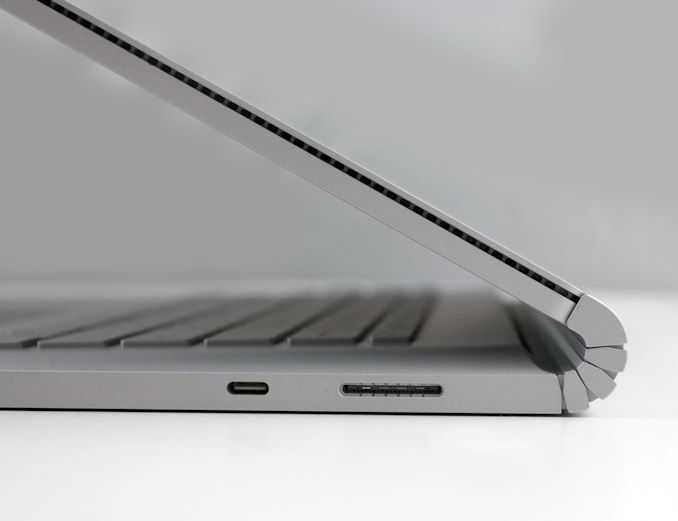The Microsoft Surface Book 3 (15-Inch) Review: A Refreshing Dip Into Ice Lake
by Brett Howse on June 3, 2020 9:00 AM EST
The PC industry has introduced some remarkably exciting designs over the last five years or so. Some of those designs, such as the thin-bezel laptop, have been adopted by almost all players in the industry. Microsoft has certainly been an innovator in the space as well, and the Surface Pro series has become the baseline for an entire category that did not exist in any volume before their launch.
But almost certainly, one of the quirkiest designs to come out of the Surface group has been the Surface Book. First launched in 2015, the Surface Book took an unusual approach to convertible laptops, incorporating an electromechanically detachable screen, and putting processors in both halves of the laptop. The original Surface Book was succeeded by the Surface Book 2 in 2017, and recently Microsoft launched the third generation of their most powerful notebook computer.
With Surface Book 2, Microsoft first introduced the 15-inch version of the notebook, and for 2020, the company is continuing to offer both 13.5-inch and 15-inch models. The electromechanically detachable tablet portion is certainly the highlight feature, and one which the entire design hinges on, pun intended. Microsoft’s Dynamic Fulcrum hinge, which expands the footprint of the base as the laptop is opened, is what provides the Surface Book with its very unique look and feel. Fittingly, for Surface Book 3, Microsoft has opted to keep chassis virtually identical to its predecessor.
Instead the Surface Book 3 is all about the internal upgrades, and they are all significant. The new Book gets an infusion of Intel's Sunny Cove CPU architecture in the form of their newest Ice Lake platform. Built on the company's 10 nm process, it is the first major architectural change since 2015's Skylake, and brings with it more performance, better power management, and a much-improved iGPU. Microsoft has also included the latest NVIDIA GPUs targeting laptops in 2020, with the smaller 13.5-inch Surface Book 3 offering an optional GeForce GTX 1650 Max-Q, while the larger 15-inch model sports the GeForce GTX 1660 Ti Max-Q, both of which are nice steps up in performance over the previous generation's GTX 1050, and GTX 1060 offerings. Also in a first for Surface, the new Book 3 is also optionally available with a NVIDIA Quadro RTX 3000, one of the company's professional-focused GPUs.
The move to Ice Lake also means that for the first time, the Surface Book 3 is now available with up to 32 GB of LPDDR4X RAM, double the maximum capacity versus the previous generation. The 16 GB limit was a function of previous Intel laptop CPUs only supporting LPDDR3, and for a laptop that competes against powerful opponents, this is an important addition.
| Microsoft Surface Book 3 | |||||
| 13.5 No GPU | 13.5 GPU | 15 As configured: 32GB / 512GB / $2799.99 |
|||
| CPU | Intel Core i5-1035G7 Quad-Core w/Hyperthreading 1.2-3.7 GHz 6MB Cache 15W TDP |
Intel Core i7-1065G7 Quad-Core w/Hyperthreading 1.3-3.9 GHz 8MB Cache 15W TDP |
|||
| RAM | Up to 32GB LPDDR4X | ||||
| GPU | Intel Iris Plus G7 | Intel Iris Plus G7 + NVIDIA GTX 1650 Max-Q 4GB | Intel Iris Plus G7 + NVIDIA GTX 1660Ti Max-Q 6GB | ||
| Storage | 256 GB to 2 TB | ||||
| Display | 13.5" PixelSense 3000x2000 3:2 sRGB Touch and Pen enabled |
15" PixelSense 3240x2160 3:2 sRGB Touch and Pen enabled |
|||
| Networking | Wi-Fi 6 802.11ax Bluetooth 5.0 |
||||
| Audio | Stereo Speakers (front facing) Dolby Audio Premium |
||||
| Battery | 78 Wh / 103 W AC | 85 Wh / 127 W AC | |||
| Xbox Wireless | No | Yes | |||
| Right Side | Surface Connect USB Type-C 3.2 Gen 2 with USB Power Delivery Headset Jack |
||||
| Left Side | 2 x USB 3.2 Gen 2 Type-A SD Card Reader |
||||
| Dimensions | 312 x 232 x 13-23mm 12.3 x 9.14 x 0.51-0.90 inches |
343 x 251 x 15-23 mm 13.5 x 9.87 x 0.57-0.90 inches |
|||
| Weight | 1.53 kg 3.38 lbs |
1.64 kg 3.62 lbs |
1.90 kg 4.2 lbs |
||
| Cameras | 8.0 MP Rear-facing camera with autofocus 5.0 MP front-facing camera with 1080p video Windows Hello IR camera |
||||
| Pricing | Starting at $1599.99 USD | Starting at $2299.99 USD | |||
Although Microsoft still seems reluctant to include Thunderbolt 3 support, they did add a USB Type-C connector on the previous Surface Book 2. That port is now upgraded to USB 3.2 Gen 2, as are the Type-A ports. The Surface Connect charging / docking connector also gets a substantial upgrade as well, and now finally allows two UHD 60 Hz display connections via the new Surface Dock.
As for wireless connectivity, Microsoft if finally moving away from Marvell network adapters as well. As a result, the Surface Book 3 goes all-Intel, using the company's AX201 adapter with Wi-Fi 6.
Past this, the Surface Book 3 sees a relatively minor refresh for 2020, with no cosmetic changes, but certainly welcome changes under the hood. When the Surface Book first launched, it was one of the most interesting laptops on the market. Now, five years later, let us see how that design holds up with some fresh internals.











125 Comments
View All Comments
YB1064 - Wednesday, June 3, 2020 - link
I own the original Surface Book (i5) with the NVidia GPU. Still going strong after all these years. Apart from the mediocre keyboard, I have no complaints. It would be nice if Anandtech can add those numbers to the comparison charts.Brett Howse - Thursday, June 4, 2020 - link
You can always use our Bench to compare anything. Link in the article as well as at the top of the page:https://www.anandtech.com/bench/product/2599?vs=15...
Our tests have changed so it will only show data where both ran the same test.
YB1064 - Friday, June 5, 2020 - link
Thank you Brett, I forgot about that.blaktron - Wednesday, June 3, 2020 - link
This review really highlights how good a value the Acer Swift 3 this generation, at like 1/2 to 1/3 the price of the cheapest Surface Book or Laptop. Both the Intel and AMD versions.Redshirt4life - Wednesday, June 3, 2020 - link
"This Mercedes S-class review really highlights what a great value the Honda Civic is!" - you, probably.blaktron - Wednesday, June 3, 2020 - link
If the Civic blew circles around the Mercedes, then yeah. That's exactly what I would say.Flunk - Wednesday, June 3, 2020 - link
Civic Type-R? On a track => smoked S-Class.It's not hard to find examples of cars that are much cheaper than an S-Class that can run circles around one. But it's just as irrelevant a comparison as comparing this to an Acer Swift 3. Which is the point the previous posted was making.
FunBunny2 - Wednesday, June 3, 2020 - link
does a Patek Philippe keep better time than a Seiko? either mainspring or quartz??devione - Friday, June 5, 2020 - link
Actually a COSC-certified Patek does probably keep better time than a Seiko.Please, (in general, not just you) stop with the internet car analogies (or watches). It's stupid.
close - Friday, June 5, 2020 - link
Well analogies are never perfect, they just have to be good enough to make a point. And in this case they still can. Even when much of that price is "the brand" you still get objective benefits that might make you choose the more expensive option. Very rarely are 2 products absolutely identical except for the logo which make one 2 times more expensive. You'll get better performance, better features, better build quality, better reliability, better feel, better support and services, etc. Any one of those can justify the price.Right next to me I have a 2008 Lenovo X200 which I used every day for the first 6 years and every week since then. Traveled with it through an airport almost every week of those first 6 years. It looks like new, it works like new. Yes it was probably 4-5 times more expensive than the equivalent Acer but under these conditions I would have probably had to buy 6 Acers to keep up.
Usually things have a certain price for a reason. At least in part you get what you pay for. If this works for you go for it.